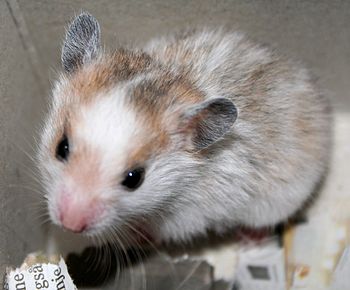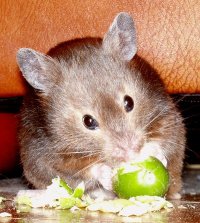The Syrian hamster is the most recommended hamster for children because they are a bit larger than the dwarf species and are also easier to tame. However, there are still many particulars with each type of hamster that you should be prepared for if you are considering getting one for a pet.
Most parents believe that getting a hamster is a good opportunity for children to learn about responsibility and how to care for an animal. Parents also find that children definitely develop a great bond between themselves and their Syrian hamster. Many are surprised to find out just how much personality each hamster displays.
 |
| A photo of one of my dwarf hamsters, Minica. (Photo credit: Wikipedia) |
The Syrian hamster grows to about 6 inches long and is sometimes referred to as the Golden hamster or teddy bear hamster. Because of their size, they are easier to handle than the smaller dwarf species, which grow to only 3 or 4 inches in length. The dwarf hamster's size and quickness allows it to escape from small children quite easily and is, therefore, a better choice of pet for older children.
Hamsters sometimes can get a reputation for nipping, but only when they are not being properly cared for. For instance, hamsters are nocturnal so they are awake most of the night and tend to sleep throughout the day. If small children try to handle them when they are supposed to be sleeping, they might find they get bit.
Because hamsters are nocturnal, you might want to consider your child's schedule. Hamsters can be great pets because they do not need a lot of care during the day. When your child is at school or at extracurricular activities, their hamster will most likely be sleeping. As long as there is a quiet area of the house for the hamster, he will be quite content.
This also means that at night, your hamster will be playing in his cage, spinning his wheel and making noise. Keeping the cage away from sleeping areas can be helpful in making sure this does not disturb your child's sleeping.
Another note to consider regarding the Syrian hamster and housing is that Syrian hamsters should never be placed in the same cage with each other. They are extremely territorial with other hamsters and will sometimes fight to the death. In nature, these hamsters are loners so you should keep them solitary in your home as well. Despite their independent nature, they do still form very deep bonds with humans.
Dwarf hamsters, on the other hand, will do well with two in a cage, as long as they have been together since they were pups. Make sure that hamsters in the same cage are of the same sex, unless you intend to breed them.
 |
| Sable short-haired Syrian Hamster. (Photo credit: Wikipedia) |
Choosing the hamster species you desire before purchasing supplies for your pet is important, as dwarf hamsters can be injured if they live in wire cages made for the larger Syrian hamster. The smaller size cage for a dwarf hamster will, necessarily, require the other supplies to be of a smaller scale.
Hamsters tend to live an average of two to three years, which is a short lifespan compared to other pets. Among hamsters though, the Syrian hamsters tend to live longer than the dwarf species. Especially with a child, you will need to consider how you will handle your pet's passing. Again, this can be another learning opportunity to discuss loss, grieving, and disappointment as your child grows.
Once you have decided whether a Syrian or a dwarf hamster will make the perfect pet for your child, find a reputable breeder or rescue mission. You can also buy a hamster from a pet store. In either case, make sure your hamster is healthy before bringing him home.
One thing to check for is a condition called wet-tail. Just like it sounds, wet-tail is moisture around the behind but it can indicate a very serious problem. Also look for dull eyes, a matted coat, diarrhea, and trembling. Of course, you should always have your new pets checked out right away by a veterinarian.
Finally, you should spend some time and effort to really investigate all of the details of each particular breed. Either the Syrian or dwarf hamster can be a great pet for your children and your entire family.
By Liz Andrews
For more information on Syrian or dwarf hamsters [
Article Source: EzineArticles
|

No comments:
Post a Comment